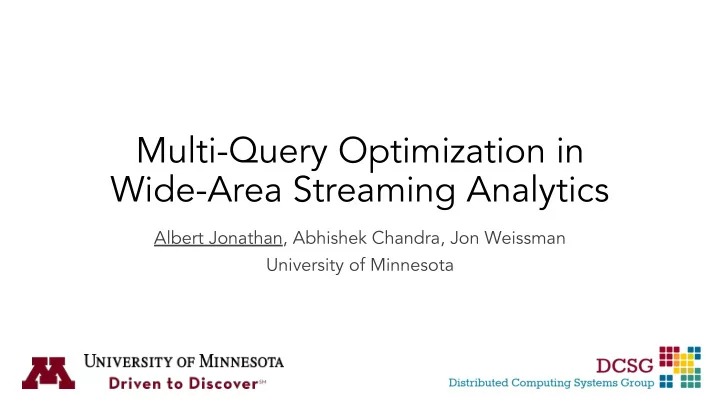

Multi-Query Optimization in Wide-Area Streaming Analytics Albert Jonathan, Abhishek Chandra, Jon Weissman University of Minnesota
Wide-Area Streaming Analytics Real-time analysis over large continuous data streams generated at the edge Trending topic analysis Location-based advertisement Meeting Internet service SLAs Billing dashboard Real-time traffic control Live video analysis
WAN Resource Demand vs. Constraints • High resource demand: • Twitter, on average 6000 tweets/second (2016) • Facebook log updates, 25TB/day (2009) • Video surveillance, millions of cameras around large cities, ~3Mbps/camera (2009) • WAN constraints: • Scarce bandwidth • High latency 32x 15x • Highly heterogeneous • Expensive ($$$)
Optimizing Queries Under WAN Constraints • Existing approaches optimize each query individually • Delay ⟺ WAN Traffic [Heintz et al., HPDC’15] • Delay ⟺ Accuracy/Quality [JetStream-NSDI’14, Heintz et al., SoCC’16, AWStream-SIGCOMM’18] • Multi-tenancy of streaming systems ”In production environment, the same streaming system is used by many teams.” • Social network: trending topic, sentiment analysis, advertisement, campaign • CDN Logs: monitored for performance optimization, debugging, billing • Optimizing multiple queries to handle WAN constraints
Optimizing Multiple Streaming Queries in Wide-Area Settings • Borrow the idea of multi-query optimization (MQO) from DBMS • Identify commonalities (data, work) between queries → remove redundancies • Adaptation for streaming analytics workload • Long-running (24x7) → incrementally optimize at runtime • Latency sensitive → minimal interruption to existing queries • Adaptation to wide-area settings • Heterogeneous, limited bandwidth → WAN-awareness
Benefit of MQO in Wide-Area Streaming Analytics Query 1: Query 2: SELECT Time, Topic, COUNT(*) SELECT Time, AdInfo.Campaign ⋈ ∪ FROM Src.US, Src.EU, Src.Asia FROM (SELECT Time, Topic GROUP BY WINDOW(Time.Minutes(1)), Topic FROM Src.US, Src.EU ∪ Ad HAVING COUNT(*) > 100 GROUP BY WINDOW(Time.Minutes(1)), Topic HAVING COUNT(*) > 100) AS Tweet, AdInfo Asia US EU WHERE AdInfo.Topic = Tweet.Topic US EU Stream rate: 5 MBps Bandwidth Usage: 40+10=50 MBps Bandwidth Usage: 40+35=75 MBps Tokyo California London Frankfurt ∪ ∪ 𝛒 ⋈ src 10 5 10 MBps MBps MBps src src src src src AdInfo 10 MBps 10 MBps 20 MBps 20 MBps 10 MBps Source.Asia Source.US Source.EU
Sana: Overview User Query DAG Existing DAGs Query Optimizer Shared Optimized WAN Recovery WAN Job Plan Info Manager Monitor Manager Job Scheduler Register DAG Deploy Geo-distributed sites
Operator Sharing • Vertices can share operators iff: • They share the same stream operator • All of their inputs are the same • Eliminate redundancies in • Input streams • Data processing • Output streams • Strict sharing requirement • Less common for vertices that are further downstream
(Partial) Input-Only Sharing • Relax the strict-equality constraints of Operator Sharing • Operators do not have to be the same Same-site/node deployment • Can share partial input streams • Router operator R • Does not perform any data transformation • Routes input streams to multiple vertices within a site/node • Only added to operators with remote inputs • Eliminate redundant input streams transmitted over the WAN
Sharing With Multiple Queries Incrementally • Which queries to share? • Query-centric: maximum similarity score → limit to 1 query • Vertex-centric: traverse vertices topologically, may be shared with multiple queries • Incremental sharing Same-site deployment
WAN-Aware Execution Sharing • Why MQO needs network awareness? 20 MBps 2 MBps available bandwidth v’s input rate Site 2 Site 1 v’s output rate 20 MBps 10 MBps • WAN-aware MQO prevents bandwidth contention
WAN-Aware Task Deployment • Vertices that exhibit commonalities: • Consider the sharing opportunities identified by the Query Optimizer • Vertices that do not exhibit commonalities: • Local inputs → same site/node deployment • WAN-aware placement: jointly optimize latency and bandwidth
Implementation • Sana prototype implementation on Apache Flink • WAN monitoring module • WAN-aware multi-query optimization • WAN-aware task placement • Managing execution states of shared queries • Router operators are proactively added • Only added to vertices that consume remote input streams • Prevent suspending existing executions
Experiment Setup • Deployment on14 Amazon EC2 data centers • Datasets & Queries • Real Twitter trace (scaled to ~6000-8000 tweets/second) • Distributed across 6 sites based on coordinates • Twitter Analytics Queries: Tweet statistics, Top-k analysis, Sentiment analysis, System metrics • Baseline Comparison: • Default: WAN-agnostic, No Sharing • MQO: WAN-agnostic, Sharing • NET: WAN-aware, No Sharing • Sana: WAN-aware, Sharing
System Comparison Latency Throughput WAN bandwidth consumption • Sana/NET: 17% higher throughput, 20% lower latency while saving 43% bandwidth • Sana/MQO: 26% higher throughput, 23% lower latency, but consume 17% more bandwidth
WAN-Aware Execution Sharing • Maximizing sharing ⇏ maximizing performance • Sana prevents bandwidth contention → higher throughput, lower latency Latency Throughput WAN bandwidth consumption Low overhead: 3~4% increase in latency
Conclusion • Sana: Multi-Query Optimization for Wide-Area Streaming Analytics • Online incremental sharing • Low overhead • WAN-aware sharing to maintain high performance executions • Maximizing degree of sharing ⇏ maximizing performance • EC2 deployment: higher performance while significantly reduce WAN bandwidth consumption
Thank You! Questions? Contact: albert@cs.umn.edu
Benefit of Partial Input Sharing • Allowing partial sharing further improves performance (41% higher throughput) while saving bandwidth consumption rate by 45% Latency Throughput WAN bandwidth consumption
Recommend
More recommend